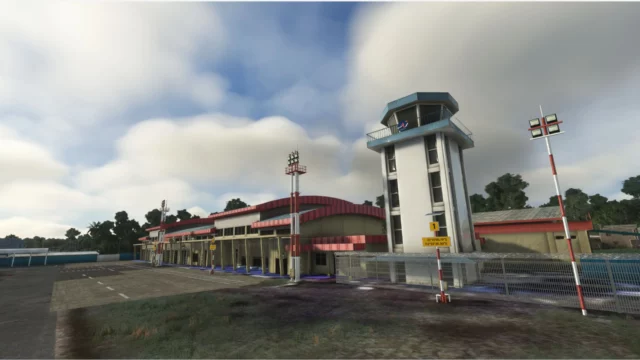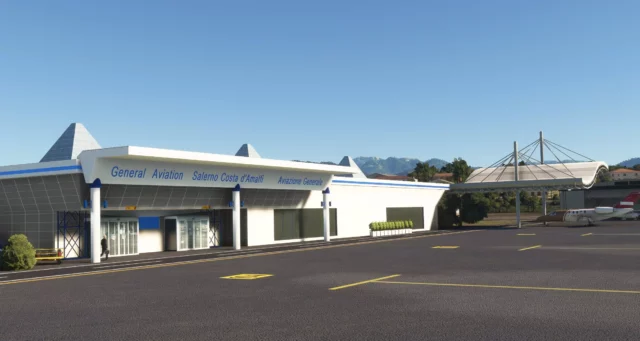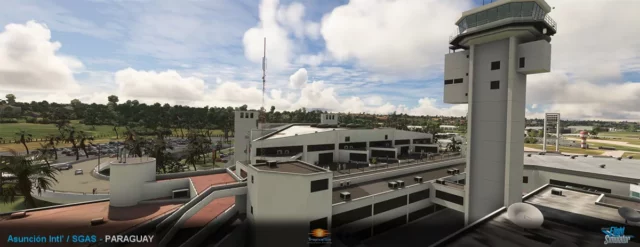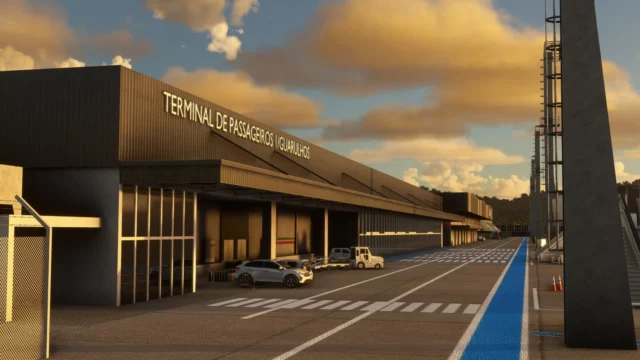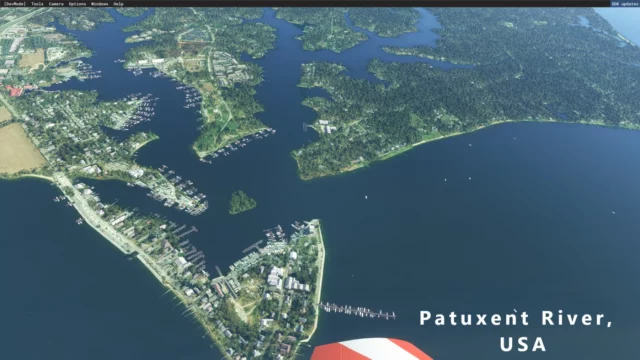 Benjamin van Soldt writes: “There are tiny airport, small airports, medium airports, and big airports. I have done about 4 scenery reviews now: Aerosoft’s Berlin Tegel, Lisbon, Stockholm Arlanda and Brussels Zaventem. Two of these are rather big, the other two could be classified as medium airports.
Benjamin van Soldt writes: “There are tiny airport, small airports, medium airports, and big airports. I have done about 4 scenery reviews now: Aerosoft’s Berlin Tegel, Lisbon, Stockholm Arlanda and Brussels Zaventem. Two of these are rather big, the other two could be classified as medium airports.
When I opted for Aerosoft’s Paris Charles de Gaulle, it’s obvious I didn’t understand what I should expect. Sure, it’s in France, and it’ll be really big. But I didn’t know just how big it would actually appear to be. I myself am from Holland, and some might know that Amsterdam Schiphol Airport is one of the biggest and most important airports of Europe. It didn’t take me long to understand that Paris Charles de Gaulle is an enormous airport. It truly is gigantic, with a footprint that I’m sure is bigger than Schiphol. ../…”
I could not understand why this is, because to me it seems Paris Charles de Gaulle, in terms of structures built on its terrain, isn’t much bigger than Schiphol. I didn’t take me long to come to the following thought: France is huge. Holland will fit at least ten times in it (didn’t check this, though). Thus, they have space, precious space we don’t have in Holland, which means we have to build very efficiently. And indeed, to me it seems Schiphol is an airport that is packed with structures, just to save that extra meter of space where one could, for instance, place a public lavatory. Maybe even an extra parking space? Who knows? So, in the end, I’m not sure Paris Charles the Gaulle is that enormous, but it sure has an enormous patch of land on which it stands. Yes, the airport rightly deserved the name Aerosoft gave it when it published it for FSX and FS2004: Mega-airport Paris Charles de Gaulle.
An overview of the airport
Many airports of recent times are just beautiful and well organized. Charles de Gaulle is also an airport with character, with interesting architecture that I haven’t yet seen very often (or not at all) at other airports. On this tour around Charles de Gaulle, where I’ll show you all the details that Aerosoft put in their scenery, I’ll take you from one end of the airport to the other, and show you what to expect. First up will be the passenger terminal, after which we go to the maintenance buildings, offices, control tower, cargo area and finally some shots of the taxiways and runway textures used to make this airport truly come to life.
Passenger terminals
Like many big, international airports, bound to the capital of their country, you can follow time when flying over the airport. Older terminal and newer terminal are distinct, and even within the newer terminal you’ll be able to see time pass by as you fly over. Charles de Gaulle is no different. Since terminal 1 was first to be opened (1974), we will begin our journey there.
The old terminal (terminal 1) is a very interesting structure. It has a centre building, which looks much like a cylinder “stuck to the ground”, with parking on top. Cars drive on the outside of it, but inside a “ring” that forms the barrier between airport staff only and visitors, as you can see on the two screenshots.
 Parking on top of the main part of the old terminal building.
Parking on top of the main part of the old terminal building.
 The main part of older terminal building from the side. You can see the cars drive around the main structure.
The main part of older terminal building from the side. You can see the cars drive around the main structure.
So where are the actual gates? Those can be found a couple of meters off the main, central building. Passengers go under the road, and into the structures that hold the actual gates, which can be admired in the following two screenshots:
As you can see, it is like a concrete island in an ocean of asphalt. Passengers go under the road by using the brownish structures that go down at the central building, and then up at the gate building. The “up” and “down” pieces can be seen in the above screenshots.
The gates themselves are quite small, but are still sufficiently big to handle a Boeing 747, as you can see by looking at one of the above screenshot, where you’ll see a Thai Boeing 747 parked at one of the gates.
The newer terminals are a small distance away from the old terminal. They are fairly characteristic, but you’ll see similar designs at other airports around the world. The basic design is of a long building, with elliptic “main buildings”, interconnected with smaller structures under which traffic can drive. The passengers go to and from the terminal by using the roads that are laid out at the core of the elliptic terminal buildings, as can be seen in the following screenshots.
 Traffic to and from the terminals, flows in between the terminals. In the Aerosoft versions, you can actually see cars drive around on these roads.
Traffic to and from the terminals, flows in between the terminals. In the Aerosoft versions, you can actually see cars drive around on these roads.
 The in-between roads even have fairly legible signs on them. Here we see an old Volkswagen van go off the main road to Terminal 2B.
The in-between roads even have fairly legible signs on them. Here we see an old Volkswagen van go off the main road to Terminal 2B.
As you can see, this is a very detailed affair, that’s really a pleasure to look at. Cars drive around roads, and here and there are traffic signs with legible text. While not as sharp as on other products I have seen, this is already very good (especially when taking into the fact that when you taxi around the airport with your Boeing 747, the chances of actually seeing and reading these signs are very small. Still, it’s nice that is there, and since it’s not very detrimental for performance, it’s a nice addition).
In the above screenshot you can see a car actually get off the main road. Yes, the car moves! It will drive on to terminal 2, which brings us to the following part of our tour: the actual “newer” terminals. The interesting thing about Terminal 2 is that it is built up of 3 of these elliptic structures I mentioned earlier, but one of these (housing terminal 2E and F), is a significantly different design. I am therefore let to believe that these were constructed later, which after some research appeared to be the case. They were opened as follows:
- 2A and B in 1982;
- 2C in 1989;
- 2D in 1993;
- 2E and F in 2004;
- What is called terminal S3 in 2008;
- 2G also in 2008.
This can be indeed seen to some degree in the overall design of the terminals, although 2B is significantly more alike 2C and D, and E and F share hardly any similarity at all. S3 is a completely different structure, and 2G is located not even in the same spot. We’ll come to that later, though.
We will tour “through” terminal 2 in the order of 2A, C, E, S3, F, D and end with B. Why this strange order? Basically, because A, C and E are all one side, and B, D and F on the other. 2G is a loose structure at the very end of terminal 2. Here below is a link to a map of Charles de Gaulle airport.
I urge you to give it a look; it will really help in understand where we are going. With our virtual tour!
First up is terminal A. Here are more screenshots than with other gates, because all we see here will be new. I can take screenshots of the same objects at every gate, but that’d be a waste of space.
 A basic overview of 2A (front) and 2C (back).
A basic overview of 2A (front) and 2C (back).
 Close-up of one of the jet ways of terminal 2A. These are quite old, and a similar type can be found at Stockholm Arlanda (one of many airports where you can find these type of jet ways, probably).
Close-up of one of the jet ways of terminal 2A. These are quite old, and a similar type can be found at Stockholm Arlanda (one of many airports where you can find these type of jet ways, probably).
 Another jet way of terminal 2A, other side. I love the detail. Look at the stairs, for example. They took the trouble to make horizontal steps!
Another jet way of terminal 2A, other side. I love the detail. Look at the stairs, for example. They took the trouble to make horizontal steps!
 This road goes under the gates, and provides space for the various push back tugs and other aircraft servicing vehicles you’ll find driving around Charles de Gaulle.
This road goes under the gates, and provides space for the various push back tugs and other aircraft servicing vehicles you’ll find driving around Charles de Gaulle.
 Another piece of road under terminal 2A, facing the other direction.
Another piece of road under terminal 2A, facing the other direction.
 Objects you’ll find around the gates. Textures are a bit blurry, but really, you won’t notice the difference from your plane.
Objects you’ll find around the gates. Textures are a bit blurry, but really, you won’t notice the difference from your plane.
In general, terminal 2A has been replicated with a great amount of detail. The textures that matter are sharp and are easy to the eye. Yes, this is a good rendition of the actual terminal 2A.
Moving on, we find ourselves at terminal 2C, which really isn’t very different from 2A. It’s only that the front of it looks more modern and the jet ways have better moveability. The textures are once again very nice and are sharp when viewed from your plane. All looks well here, too.
 As you can see, the terminal has a beautiful, glass front. Seems a lot nicer than the drab brown and yellowish white of 2A.
As you can see, the terminal has a beautiful, glass front. Seems a lot nicer than the drab brown and yellowish white of 2A.
 A terminal 2C jet way. Definitely more versatile than the 2C jet way!
A terminal 2C jet way. Definitely more versatile than the 2C jet way!
 Again the jet way, but also notice the people. A recurring bitmap, but still a very nice addition. Can be a bit weird, though, if there is no aircraft docked…
Again the jet way, but also notice the people. A recurring bitmap, but still a very nice addition. Can be a bit weird, though, if there is no aircraft docked…
Moving on, we get to terminal 2E. This terminal has somewhat of a rough history. Designed by Paul Andreu, like the rest of the airport, the terminal had built-in problems that eventually ended up in part of 2E collapsing. Not sure what had happened, Andreu accused the building companies, and it seems he was right: the strength of the building had to come from the materials used, and to cut costs, exactly these materials were treated in a way with which they assumed would leave the building standing but cost less. That said the design itself had its problems too. The structure, resembling a very long tube without supports, was weakened by openings in the roof, and combined with sub-optimal building materials; it failed and came down, killing four people and hurting several people. When the investigatory comity finally announced their findings, the directorate of Charles de Gaulle decided to rebuild the terminal at an additional cost of 100 million Euros.
Despite the disturbing history, 2E has become a grand terminal, and the design, while initially crooked, truly is an impressive one. First some screenshots:
 Traffic driving around terminal 2E.
Traffic driving around terminal 2E.
As you can see, terminal 2E is like a tube of glass, and Aerosoft replicated it faithfully. Nicest thing here is the reflection effect on the terminal building. As you move your view, there is a sun reflection effect that appears or disappears (diminishes is a better wording, probably). This can be partly seen on the middle screenshot, where you see the rightmost part of 2E is quite a bit different in colour. This, indeed, is part of the sun reflection effect you see, and is not a discoloration of the screenshot or the terminal building’s textures. It adds to the ambience of the airport on sunny days and is the detail I like to see in sceneries.
For the rest, it’s the usual: good quality texturing and multiple objects at gates and such is a welcome addition. The jet ways are modelled well and look good, and are, as always, very detailed. The texturing of the roof the terminal isn’t as great, however, and it’s frequently blurry, but that’s understandable: it’s not something you will see from close by, rather only from high up when flying over it.
Finally, here’s a screenshot of what I presume is an extension of terminal 2E, but to be frank, I’m not too sure what it belongs too:
 I suppose this belongs to 2E (it is interconnected with 2E by an underground walkway, anyway…
I suppose this belongs to 2E (it is interconnected with 2E by an underground walkway, anyway…
 Terminal S3 from the other side.
Terminal S3 from the other side.
 Jet way detail. Look closely: you’ll see there are three jet ways, one clearly meant for an upper deck: A380!
Jet way detail. Look closely: you’ll see there are three jet ways, one clearly meant for an upper deck: A380!
Searching around, on the map it appears as “Galleries Parisiene”, and it is called terminal S3, and was tailored to the needs of the A380 (just look at the rightmost screenshot. You’ll notice there is a third jet way, clearly meant for an upper deck). It was opened in 2008, meaning it’s an even later structure than 2F and E. Not very surprising if you look at the (again) very different architecture.
Aerosoft has done a good job here too. It all looks authentic. Texturing is again good; the objects at the gates look nice and add to the overall experience. A very nice terminal indeed.
Now we slowly go back in time. Next up is 2G, which has a completely different design from anything seen until now. It ahs the basic layout, but on it are two piers, with a lot of gates in it. Looking at the jet ways, you’ll notice the structure and “flow” of passengers: one comes out at the top, walks down to the aircraft to board. When one leaves the aircraft, you go to the right: down to the first floor of the terminal. A very efficient way to handle passengers!
 One of the two “piers” of terminal 2F.
One of the two “piers” of terminal 2F.
 Zoomed in on the jet ways: notice the way they are connected to the pier.
Zoomed in on the jet ways: notice the way they are connected to the pier.
 Zoomed in even more. Very good texturing and nice detailing.
Zoomed in even more. Very good texturing and nice detailing.
You’ll probably agree with me that the texturing here, too, except for the roof, is good. The roof again is somewhat blurry. But for the rest, all is well. The modelling is detailed and looks well done. Not sure what else to say; it’s all looking good!
 TGV station between terminal 2F and D.
TGV station between terminal 2F and D.
Before we move on to terminal 2D and B, here is a shot of the TGV station between terminal 2D and F. The roof is entirely made of glass, and looks very good, except for the slightly blurry textures. However, it does have the rather neat glass reflection effect I discussed earlier, when we looked at gate 2E.
Terminals 2D and B are very alike, and you’d think both have been constructed simultaneously. This is not the case, as I said earlier. Quite the contrary! They are 11 years apart.
 Overview of gate 2B and D (D at the front B in the distance).
Overview of gate 2B and D (D at the front B in the distance).
Texturing is good, modelling is, again, extraordinary, and there are multiple objects to keep you company when taxiing to and from the gates. All in all very well done!
Something I noticed is the fact that there are multiple types of gates at terminal 2B. While terminal 2D has the type we spotted earlier on at 2A, 2B seems to have some of the “normal” jet ways too, like in the right screenshot. However, there are also some jet ways of the type of 2A and D. A curious decision that I don’t quite understand, but they must have had their reasons. Money, perhaps?
The last terminal that belongs to terminal 2 is 2G. It is located father away, and is the newest, opened in September 2008. It is rather curious, because you’d actually be inclined to call it “terminal 4”, rather than 2G:
 Gate 2G. Lonely lonely lonely…
Gate 2G. Lonely lonely lonely…
As you can see, it’s in the middle of nowhere. Nothing even in the near vicinity… It is to be used by the regional partners of Air France, like Cityjet, which fly on national and Schengen routes. Aerosoft did a nice job replicating it. Texturing is good and the modelling looks okay. It seems a bit bare, though, but I guess that’s just because the way the place looks… Just a pity there is nothing parked here. Not like Aerosoft can do something about that situation, though…
And that’s the end of terminal 2, but we are not done yet. Now comes terminal 3, which was originally opened in 1990, and is aimed at low cost charter airlines. It doesn’t seem to have many facilities, but it does the job and offers the low cost airlines a “low cost” place to park their plane.
 Overview of terminal 3: no jet ways, just busses driving around.
Overview of terminal 3: no jet ways, just busses driving around.
 Busses drive through the passage and await their passengers.
Busses drive through the passage and await their passengers.
 View from under the roof, viewing terminal 3’s apron.
View from under the roof, viewing terminal 3’s apron.
Aerosoft has replicated this terminal also with quite a bit of detail. A nice added touch is the rather big amount of traffic driving around the airport. Because there are no jet ways, it looks a little bare, but the busses make up for it. It’s entertaining to sit in your 737-500 and watch the busses pass. Again, Aerosoft has done its job well.
This concludes the terminals. It’s time to move on to the cargo depot!
Cargo depot and surroundings
The cargo depot at Charles de Gaulle is enormous. Terminal 2 could easily for into it. It is laid out in a corner, with the big depots at one “leg”, and the seemingly smaller ones (together with an amount of warehouses) one the other leg, as can be seen here:
Overview of cargo depot. At the back we see several Boeing 747s at the seemingly larger “leg”.
 …and traffic on the other side, driving around between the warehouses.
…and traffic on the other side, driving around between the warehouses.
The buildings themselves look pretty good and I also like their texturing. The roofs have the standard blurriness, but as you’ll soon see: when flying higher, this is of no concern. First, though, some shots of the cargo depot:
 Boeing 747s at the cargo depot.
Boeing 747s at the cargo depot.
Warehouses and offices at the cargo depot. At the cargo depot. I really like the texturing here.
At the cargo depot. I really like the texturing here.
 Warehouses and offices at the cargo depot.
Warehouses and offices at the cargo depot.
I’m pleased with how this looks. Where necessary texturing is sharp and the modelling of the buildings goes into just the right amount of detail. overall a very nice presentation of reality.
Some other small things that deserve mentioning
Now that we have seen the most important parts of the airport, it’s time to give a look at other, smaller things that add a nice touch to the overall airport scenery, or that for themselves noteworthy.
First of all this:
When AES is installed, it is of little importance to you, since, when there is no automatic way of parking your aircraft, you will see the same guy telling you what to do. However, if you don’t have AES installed, this is very valuable, and it’s at every gate, for as far as I could see. When you get close enough to a gate, this guy is automatically activated, and will give you cues to park your aircraft safely. It works, and works well, and is a very nice addition to an already detailed airport.
Next up, we have some offices and hotels and other buildings I found to be nice. In itself, the texturing of these buildings isn’t great, and the modelling also isn’t extraordinary, but still. It adds to the atmosphere and just is a very thing to see. I don’t think it’s something that could have been left out, though, it’s too important, but given that it’s not directly related to any of the terminals (or other structures you’ll see from close-by), the detail of these building is just enough to satisfy your needs without bogging down FPS unnecessarily.
 The hotels, adjacent to terminal 2.
The hotels, adjacent to terminal 2.
 The airport’s fire department, with a nicely textured fire truck outside.
The airport’s fire department, with a nicely textured fire truck outside.
 Once the pinnacle of modern day engineering, it is now but a memory of times past: the Concorde. Very good looking modelling here, I must say!
Once the pinnacle of modern day engineering, it is now but a memory of times past: the Concorde. Very good looking modelling here, I must say!
 The CDGVAL train is the train you’ll see driving between the terminals. It connects all of them and makes it possible to have quick, easy and comfortable transportation. In the scenery, it moves, too!
The CDGVAL train is the train you’ll see driving between the terminals. It connects all of them and makes it possible to have quick, easy and comfortable transportation. In the scenery, it moves, too!
Finally, we have the control tower. There actually are multiple on this airport. Flying around, I counted three: two big ones (new and old, I guess the new one was made to comply with new regulations) and a small one, over at terminal S3 and 2G. Here below we see the big, old control tower:
 Neat, sharp texturing of the windows and radar dome.
Neat, sharp texturing of the windows and radar dome.
 Ouch… that texturing is very blurry! Fortunately, we won’t have to see it this way when driving around the airport.
Ouch… that texturing is very blurry! Fortunately, we won’t have to see it this way when driving around the airport.
Mother Earth
Last thing to look at is the ground, Â more specifically at the ground textures. How do they look? Are they blurry, or is it okay? And what about compatibility with Ultimate Terrain, for instance? Well, take a look:
 And even more taxiway bridges…
And even more taxiway bridges…
 Ground texture around the train hangar.
Ground texture around the train hangar.
 Ground textures when flying a bit higher.
Ground textures when flying a bit higher.
These screenshots show you what you can expect. Basically, the higher you get the better it looks. The many taxiway/road crossings will show you that the taxiways themselves have a sharpness that you will not see with the ground textures, but when you fly higher, the ground textures look great, and it’s just awesome to behold. The train hangar is a very good example, again, of blurry ground textures. The other reason I chose that screenshot, is because I love these little trains and I love that Aerosoft put a train model there. It adds a lot! That said why do the rails abruptly end…?
And what about Ultimate Terrain? A good question, see for yourself:
 Photo scenery of CDG and Ultimate Terrain: Europe.
Photo scenery of CDG and Ultimate Terrain: Europe.
As you can see: it’s perfect, it’s simply great. The highway doesn’t even have a single pixel offset. It flows directly into CDG’s photoscenery, with the added bonus that the photoscenery does not abruptly end, either. It “dims” and “flows” into the default textures. This is truly a masterpiece!
Performance
And now the big question. Aerosoft Charles de Gaulle is huge scenery with a lot of detail, so how does it fare in the performance department? Let me first say I did all my tests in FS9. I used the default Bell 206 and Cessna, and the PMDG 747 and the Wilco Airbus A340. Here is small rundown of my FPS (all values are from within the VC!):
- Default Bell 206/Cessna: 17-19 FPS
- Wilco Airbus A340: 7-9 FPS
- PMDG 747: 9 — 11 FPS
Surprisingly, the PMDG 747 had a better score, but this behaviour is consistent amongst all my heavy airport sceneries. For me, these FPS values are flyable and are twice the FPS I got from the FSX version. Do note that once you take off and the scenery isn’t in view, your FPS will slowly increase and get back to the amount of FPS you usually enjoy. At night performance was slightly worse, but not a lot, even though I have UT installed, it didn’t seem to matter in my installation.
AES?
An important factor, for me, is AES support. Since it came out, it ahs made ground operations enjoyable, and airports that have it deserve my attention. I’m happy to report that both the FS9 and FSX versions of Aerosoft Charles de Gaulle airport have AES support. It will cost 5 credits.
Conclusion
I have many Aerosoft sceneries in my collection. Some are very frame rate friendly (Lisbon), other less so (Brussels). Some are big (Stockholm Arlanda), some are smaller (Berlin Tegel), but Charles de Gaulle is in a different league. It is huge, yet very detailed, and blends into the default scenery in such a way that you can easily enjoy it without being taken out-of-place Aerosoft scenery, in a sea of dull default scenery. If anything, I think this is the best scenery by Aerosoft I have come across. I recommend to those interested in flying to Paris and I know I’ll be landing there now and then, to admire this magnificent work of art. For the price you pay, you get a lot!
Important details
- Developer: Â Aerosoft
- Medium: Download/Boxed
- File size: Â 104MB (FS9)/171MB (FSX)
- FS version: Â FS9/FSX
- Approximate price at the time of writing:Â 25 euros
Reviewed by Benjamin van Soldt
My systems specs:
Macbook pro with: Windows XP 32bit, 4GB RAM. Nvidia 8600GT, 300GB Hard disk (dedicated FS9 disk), Intel T8300 2,4 gHz Dual Core processor

















![[Video🎬] New Trailer 4K for Turkish Airports MSFS by SceneryTR Design – Istanbul – Ankara Trabzon by SIMMARKET](https://www.simflight.com/wp-content/uploads/2024/04/SceneryTR_thumb.jpg)
